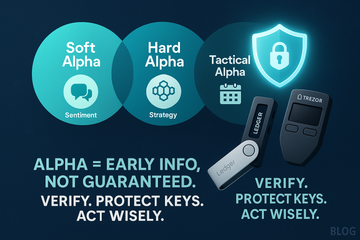Arbitrage sounds fancy, but the idea is simple. You buy an asset where it is cheaper, and sell it where it is pricier, as close to the same moment as you can. The spread between the two prices is your reward. In crypto, where prices shift by the second and liquidity lives across dozens of venues, those tiny gaps show up all the time. Honestly, they feel small, then they add up.
Let me explain with a clean picture. Suppose BTC trades at 67,980 on Exchange A and 68,040 on Exchange B. You buy one BTC on A and sell one BTC on B. If fees and slippage are low, the difference is yours. That is the core move. Everything else is technique, tooling, and risk control.
So, what counts as crypto arbitrage?
There are a few flavors. Some are quick and loud. Others are slow and patient. All of them watch the same thing, price differences that should not last, yet do for a moment.
Cross exchange, the classic spread
Buy on one centralized exchange, sell on another. This is common during news bursts, Asia to US session handoffs, or when one venue is thin. You know what? Weekend liquidity often gets quirky, and spreads can open when market makers step back.
Triangular arbitrage inside one venue
Trade three pairs on the same exchange to capture a mismatch. For example, start with USDT, move to ETH, then to BTC, and back to USDT. If the implied cross rate of ETH and BTC is off, the loop yields a gain. It happens, especially when pair liquidity is uneven.
DEX to CEX, and CEX to DEX
Decentralized exchanges do not always track centralized ones in lockstep. Gas fees, liquidity pools, and routing quirks can create pockets of price. Buying on Uniswap or Curve, selling on Binance or Kraken, or the other way around, can work when the pool is off balance.
Funding rate and basis trades
Perpetual futures pay funding. If longs pay shorts, you can hold a short perp and a spot long, then pocket the funding, assuming the hedge stays tight. A cash and carry is similar with dated futures. Go long spot, short the quarterly future, clip the basis as it converges into expiry. Simple idea, careful margins.
Stat arb, the slow burn
Pairs trading and mean reversion strategies lean on data. They seek small, repeatable discrepancies. It is quieter, less flashy, yet steady when tuned well. You spend more time on research, less time on hype.
Costs, frictions, and the sneaky stuff
Spreads look tasty until fees and frictions take a bite. Winning traders treat costs like gravity. They do not ignore it. They build around it.
- Fees: Maker and taker fees, withdrawal fees, network fees, borrow fees for shorts.
- Slippage: Market impact gets you on thin books. Splitting orders helps, but speed matters.
- Latency: APIs, websockets, and your own code add delay. Milliseconds pile up during volatility.
- Transfer risk: Moving funds between venues can stall. Blockchain congestion, stuck mempools, or withdrawal queues ruin timing.
- Smart contract risk: DEX swaps carry contract and MEV risk, especially on volatile days.
Here is the thing, a great idea with poor execution loses money. A modest idea with tight execution can print day after day.
Tooling that actually helps
You do not need a PhD stack to get moving, but you do need clean data and a practical workflow. Start with exchange APIs and a solid SDK like ccxt. Add Python or Node for scripting. Use websockets for live tick data. Build a simple sanity check on prices across a few venues, then add execution rules.
For DEX routing, look at 1inch, 0x API, or Cow Swap for better paths. Hummingbot can help you prototype. Keep logs. Keep timestamps. When your logs tell you why a fill slipped, you learn faster than any thread on X will teach you.
Security is not optional
Fast profits mean nothing if your keys wander off. Park long term funds in a hardware wallet like a Ledger or Trezor. Whitelist withdraw addresses on exchanges. Use unique API keys with granular permissions. Keep trading balances lean. Cold storage for treasury, hot wallets for working capital. It sounds conservative, and it should. Many traders survive because they treat security as part of PnL.
A short, real world style walkthrough
Picture this. ETH trades at 3,108.50 on Exchange X and 3,114.90 on Exchange Y. Your combined fees to buy and sell are 0.10 percent per side. Slippage on both sides takes 1 dollar total. You buy 50 ETH on X, you sell 50 ETH on Y.
Gross spread per ETH is 6.40. Multiply by 50, gross is 320. Fees are roughly 0.10 percent on each leg, so about 3.11 per ETH round trip, near 155 total. Add 1 dollar slippage and a tiny withdrawal fee if needed. You are left with roughly 160. Not fireworks, yet repeatable when the window opens. Scale carefully, because big size changes your average fill.
DeFi quirks, MEV, and staying calm
On chain, your trades sit in a public queue. Searchers watch for free money. Sandwich attacks push your buy higher, then your sell lower. Use private transaction relays where possible, like MEV Blocker or Flashbots Protect. Cow Swap settles orders through batch auctions, which can reduce exposure. Keep gas settings realistic. Cheap gas can be costly if you miss the window.
When do spreads widen?
Spreads often expand during fast news, weekend hours, and maintenance windows. They also pop during stablecoin wobbles, think of the USDC depeg scare in March 2023. Cross chain bridge pauses can break routing for hours, creating local price pockets. Holidays shift liquidity too. New Year in Asia, summer in Europe, and football Sundays in the US produce odd patterns.
Common mistakes, and how to dodge them
- Ignoring settlement: You booked a paper gain, but funds got stuck. Always model the path of capital.
- All in size: Big size breaks your own edge. Grow slowly. Test fills.
- Fee blindness: The spread is visible. Fees hide in settings. Know your tiers.
- Wallet slop: Reuse of addresses, weak API keys, or no allowlists. Treat keys like cash.
- Rule drift: You change rules mid trade. Write them down. Follow them until your data says change.
A tiny playbook to get started
Pick two or three exchanges you trust, like Coinbase Advanced, Kraken, or Binance for liquidity. Add one DEX venue for comparison. Set up accounts, KYC where needed, and confirm withdrawal times. Fund small. Use a watchlist of five majors, BTC, ETH, SOL, XRP, and a stablecoin pair.
Write a checker that flags spreads over a threshold after fees, say 0.30 percent net. Include a minimum notional so you do not chase crumbs. Paper trade for a week. Record every event, including fails. Then trade tiny size for another week. Your goal is execution, not jackpot payouts. If it feels boring, that is actually good.
A quick word on taxes and records
Track lots and timestamps. Arbitrage creates many trades. Your accountant will thank you, and your future self will too. Tools like CoinTracking, Koinly, or a custom spreadsheet can make the mess tidy.
Edges fade, edges return
Markets learn. Once a spread gets popular, it shrinks. Then a new venue launches, or a token gets listed, and the cycle repeats. Keep your system simple enough to tweak, and sturdy enough to survive noise. Small, steady wins, with cold storage for profits, makes for a long career rather than a hot month.
And yes, arbitrage is not always thrilling. It feels like picking coins on a sidewalk while traffic roars by. But those coins count. With clear rules, respect for costs, and a safe home for your keys on a Ledger or Trezor, the quiet edges can pay. You stay patient. You stay curious. The spreads do the rest.











